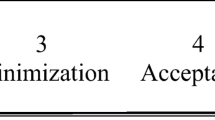Abstract
Research on teacher expectations and student success suggests that teachers' beliefs about students lead to differential expectations and treatment of students. Few qualitative studies aimed at understanding teacher beliefs about diversity and multicultural commitment have been done. This study utilized combined quantitative and qualitative methods to explore the attitudes, beliefs, and commitments of a predominantly Anglo-American population of preservice teachers enrolled in a diversity course. The results describe beginning attitudes, beliefs, and commitments to diversity; changes (or lack of change) in attitudes, beliefs, and commitments after participation in a diversity course; some theoretical underpinnings for understanding changes (or lack of change); and a framework for facilitating positive multicultural experiences.
Similar content being viewed by others
REFERENCES
Allport, G. W. (1935). Attitudes. In C. Murchison (Ed.), Handbook of Social Psychology (pp. 798–884). Worchester, MA: Clark University Press.
Allport, G. (1979). ABC's of Scapegoating. New York: Anti-Defamation League of B'Nai B'rith.
Banks, J. A. (1994). Multiethnic Education: Theory and Practice. Needham Heights, MA: Allyn &; Bacon.
Bennett, C. I. (1995). Comprehensive Multicultural Education: Theory and Practice. Needham Heights, MA: Allyn &; Bacon.
Bennett, M. J. (1986). A developmental approach to training for intercultural sensitivity. International Journal of Intercultural Relations 10: 179–196.
Butler, K. A. (1986). Learning and Teaching Style: In Theory and Practice. Columbia, CT: Learner's Dimension.
Cooper, J., and Croyle, R. (1984). Attitudes and attitude change. Annual Review of Psychology 35: 395–426.
Deschamps, J. C. (1982). Social identity and relations of power between groups. In H. Tajfel (Ed.), Social Identity and Intergroup Relations. Cambridge, UK: Cambridge University Press.
Festinger, L. (1957). A Theory of Cognitive Dissonance. Stanford, CA: Stanford University Press.
Fishbein, M., and Ajzen, A. (1974). Attitudes toward objects as predictors of single and multiple behavioral criteria. Psychological Review 81: 59–74.
Fishbein, M., and Ajzen, A. (1975). Belief, Attitude, Intention, and Behavior: An Introduction to Theory and Research. Boston, MA: Addison-Wesley.
Howard, G. R. (1993). Whites in multicultural America: Rethinking our role. Phi Delta Kappan 75(1): 36–41.
Hower, J. A., Bankins, M., and Crahen. S. (1987). Appreciation of Differences: Riddle Scale of Homophobia. Paper presented at the meeting of ACPA/NASPA Celebration, Chicago.
Katz, J. H. (1989). White Awareness: Handbook for Anti-Racism Training. Norman: University of Oklahoma Press.
Marcia, J. E. (1966). Development and validation of ego identity status. Journal of Personality and Social Psychology 3: 551–558.
McGuire, W., McGuire, C., Child, P., and Fujioka, T. (1978). Salience of ethnicity in the spontaneous self-concept as a function of one's ethnic distinctiveness in the social environment. Journal of Personality and Social Psychology 36: 511–512.
McIntosh, P. (1988). White Privilege and Male Privilege: A Personal Account of Coming to See Correspondences Through Work in Women's Studies. Wellesley: Wellesley College Massachusetts Center for Research on Women. (ERIC Document Reproduction Service No. ED 335 262)
Nespor, J. (1987). The role of beliefs in the practice of teaching. Curriculum Studies 19(4): 317–328.
Pajares, M. F. (1992). Teachers' beliefs and educational research: Cleaning up a messy construct.Review of Educational Research 62(3): 307–332.
Phinney, J. S. (1989). Stages of ethnic identity development in minority group adolescents. Journal of Early Adolescence 9: 34–49.
Phinney, J. S. (1990). Ethnic identity in adolescents and adults: A review of research. Psychological Bulletin 180: 499–514.
Pohan, C. A., and Aguilar, T. E. (1995). The Beliefs About Diversity Scale: User Manual and Scoring Guide. Lincoln: Department of Educational Psychology and the Center for Curriculum and Instruction, University of Nebraska-Lincoln.
Rajecki, D. W. (1990). Attitudes. Sunderland, MA: Sinauer Associates.
Roberts, D. (1975). The treatment of cultural scripts. Transactional Analysis Journal 5(1): 29–35.
Triandis, H. C. (1971). Attitude and Attitude Change. New York: Wiley.
Author information
Authors and Affiliations
Rights and permissions
About this article
Cite this article
Middleton, V.A. Increasing Preservice Teachers' Diversity Beliefs and Commitment. The Urban Review 34, 343–361 (2002). https://doi.org/10.1023/A:1021372801442
Issue Date:
DOI: https://doi.org/10.1023/A:1021372801442




